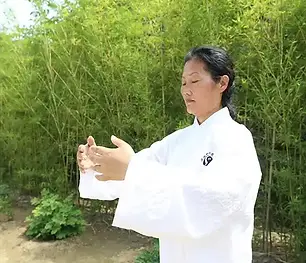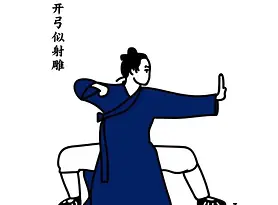
Wudang Qigong
-Ancient Taoist Practices for Health and Vitality
Wudang Sanfeng School Qigong System and Its Detailed Practices
The Wudang Sanfeng School, founded by Zhang Sanfeng (circa 13th–15th century) during the Ming Dynasty, is a significant branch of the Wudang school, renowned for its integration of internal and external cultivation and a balance between hardness and softness. Wudang Sanfeng Qigong incorporates Taoist (Daoist) internal alchemy (Neidan), guided breathing (Daoyin), and martial Qigong to achieve health preservation, longevity, and enhanced internal energy cultivation, forming a comprehensive system of practice.
Major Qigong Systems of the Wudang Sanfeng School
The Wudang Sanfeng School encompasses a wide range of Qigong styles, including static health-preserving Qigong and dynamic martial Qigong. Below are the core Qigong practices of the Sanfeng lineage:

1. Wudang Taiji Qigong
Features: Combines the gentle, flowing movements of Taijiquan with internal breathing techniques to regulate Qi circulation and balance Yin and Yang.
Practice Methods:
• Focuses on Dantian breathing, guiding Qi through slow, even, soft, and circular movements.
• Uses relaxed and sunken postures to allow Qi to settle in the Dantian while employing mind-intent guidance for Qi circulation.
• Integrates spiral movements (Chansi Jin) and push-hand exercises to enhance Qi perception and power generation.
Benefits:
• Regulates Qi and blood circulation, improving organ function.
• Balances Yin and Yang, enhancing immunity.
• Improves Taijiquan combat skills.

2. Wudang Zhan Zhuang
Features: Develops internal strength through stillness, cultivates core stability, and builds a foundation for all Wudang martial arts and internal training.
Practice Methods:
• Wuji Stance: Feet shoulder-width apart, knees slightly bent, hands naturally relaxed, focusing on the Dantian to enter a deep meditative state.
• San Ti Shi (Three-Body Stance): Adopts a Tai Chi-inspired posture with circular arm positioning, coordinated with abdominal breathing to enhance Qi flow.
Benefits:
• Strengthens the lower body and improves overall stability.
• Enhances Qi circulation and physical endurance.
• Forms the foundational practice for Wudang martial arts, sword techniques, and internal power training.

3. Wudang Five Elements Qigong
Features: Based on the Five Elements Theory (Wood, Fire, Earth, Metal, Water), this practice uses specific movements and breathing techniques to regulate the five major organs.
Practice Methods:
• Wood Qigong (Liver Nourishment): Expansive chest-opening movements stimulate liver meridians and alleviate liver stagnation.
• Fire Qigong (Heart Nourishment): Rising and descending movements balance heart fire, calming the mind and emotions.
• Earth Qigong (Spleen Nourishment): Abdominal massage and specific postures enhance digestion and spleen function.
• Metal Qigong (Lung Nourishment): Controlled breathing exercises strengthen lung capacity and boost immunity.
• Water Qigong (Kidney Nourishment): Relaxed waist movements and sinking postures replenish kidney Qi and vital energy.
Benefits:
• Regulates organ function and improves overall health.
• Promotes meridian circulation, preventing diseases.
• Enhances vitality, endurance, and Qi development.

4. Wudang Eight Pieces of Brocade (Ba Duan Jin)
Features: The Wudang version of Ba Duan Jin integrates Daoist health principles, emphasizing Dantian focus and whole-body Qi flow.
Practice Methods:
• Draws Qi from nature through deep, controlled breathing and slow, stretching movements.
• Uses shoulder relaxation, hip opening, and breath regulation to facilitate Qi flow.
• Each movement corresponds to a specific organ system, enhancing its function.
Benefits:
• Improves blood circulation and body flexibility.
• Clears meridians and strengthens the immune system.
• Relieves stress and enhances sleep quality.

5. Wudang Rejuvenation Qigong (Internal Nourishment Practice)
Features: Based on the principle of “movement within stillness and stillness within movement,” this practice integrates guided breathing and gentle movements to revitalize the body and mind.
Practice Methods:
• Uses slow, circular hand movements with deep breathing to regulate energy flow.
• Combines standing meditation and gentle swaying to enhance Qi circulation.
• Focuses on mind-intent coordination, calming the spirit and harmonizing the body.
Benefits:
• Boosts circulation and strengthens the body.
• Regulates the nervous system, reducing stress.
• Enhances vitality and slows down aging.

6. Wudang Huogu Qigong
Features:
A dynamic Qigong system designed to activate and nourish the bones, joints, and tendons, promoting flexibility, strength, and smooth Qi circulation. Rooted in Daoist internal cultivation, it harmonizes movement, breath, and intention to enhance vitality and overall well-being.
Practice Methods:
• Utilizes gentle yet stimulating joint rotations, stretches, and shaking techniques to loosen stiffness and improve mobility.
• Incorporates deep, rhythmic breathing to enhance Qi flow and support internal energy circulation.
• Emphasizes relaxation and mind-intent (Yi) to guide Qi into the bones and connective tissues, reinforcing structural integrity.
• Combines standing postures and dynamic movements to strengthen the skeletal system and improve alignment.
Benefits:
• Promotes joint health, reduces stiffness, and enhances flexibility.
• Stimulates bone marrow activity, supporting bone density and regeneration.
• Improves circulation of Qi and blood, accelerating recovery from injuries.
• Strengthens tendons and ligaments, enhancing overall body coordination and resilience.

7. Wudang Secret Five-Animal Qigong
Features:
An ancient internal cultivation practice passed down within Wudang Daoist tradition, the Wudang Secret Five-Animal Qigong integrates health preservation, energy cultivation, and martial applications. This system consists of five primary forms—Turtle, Snake, Dragon, Tiger, and Crane—each inspired by sacred and powerful creatures in Chinese tradition. These forms correspond to the Five Elements (Water, Metal, Wood, Earth, Fire) and regulate the body’s internal functions to achieve optimal vitality, mental clarity, and energetic balance.
Practice Methods:
• Turtle Form (Water – Kidneys): Slow, steady, and flowing movements cultivate longevity, wisdom, and tranquility. Regular practice nourishes the kidneys, promotes fluid production, and enhances flexibility.
• Crane Form (Fire – Heart): Graceful, elegant movements elevate spirit and refine internal energy. Practicing the Crane form increases vitality, sharpens mental clarity, and uplifts the spirit.
• Snake Form (Metal – Lungs): Soft, coiling motions enhance breath control and lung function. This form promotes respiratory health, strengthens the lungs, and increases overall agility.
• Tiger Form (Earth – Spleen & Stomach): Strong, powerful movements develop resilience and internal strength. Practicing the Tiger form strengthens the digestive system, fortifies bones, and boosts overall endurance.
• Dragon Form (Wood – Liver & Gallbladder): Expansive, fluid, and spiraling movements enhance Qi circulation and spiritual awareness. This form supports liver health, increases blood vitality, and balances emotions.
Benefits:
• Aligns the body’s Qi with the Five Elements, promoting internal harmony.
• Strengthens vital organs, improving overall health and longevity.
• Enhances flexibility, coordination, and energy flow.
• Cultivates mental clarity, resilience, and spiritual awareness.
• Supports martial applications by refining internal power and agility.
Conclusion
The Daoist principles of natural harmony, softness overcoming hardness, and internal energy cultivation form the foundation of the Wudang Sanfeng School’s Qigong system. Whether for health maintenance, martial arts enhancement, or spiritual development, Wudang Qigong provides a holistic path to balance and longevity.
The Wudang Sanfeng Qigong system is diverse, incorporating static internal training, dynamic external training, and martial applications. Taiji Qigong, Five Elements Qigong, and Ba Duan Jin focus on health preservation, while Vajra Qigong and Martial Qigong enhance combat effectiveness and resilience.
By following a gradual and systematic approach, practitioners can develop a profound understanding of Qi, leading to a harmonious integration of body, mind, and spirit, ultimately attaining the Daoist ideal of unity with nature.